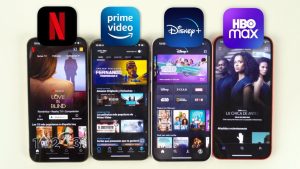Art /Entertainment
The Impact of Globalization on Film Industry Trends

Introduction
Globalization has shaped almost every sector across the globe, and the film industry is no exception. As films transcend borders and reach audiences worldwide, the impact of globalization on film industry trends is undeniable. In this article, we will explore the various ways globalization has affected filmmaking, distribution, and consumption, as well as how it has influenced trends such as content diversity, international collaborations, and the role of streaming platforms. By the end, we’ll provide an analysis of key trends, accompanied by comparison and analysis tables to offer a clearer picture of these changes.
The Rise of Global Film Markets

Image by: Yandex.com
In the past, the film industry was mostly dominated by Hollywood, with major film releases targeting a primarily Western audience. However, globalization has led to the emergence of powerful film markets across the world, especially in countries like China, India, and South Korea. These markets have not only grown in size but have also begun to influence the types of films that are produced and the way they are marketed.
China, for example, has become the second-largest box office market globally. As a result, Hollywood studios now make significant efforts to tailor their films to Chinese audiences, sometimes including Chinese actors or cultural references to enhance appeal. Similarly, Bollywood has expanded its reach beyond India, and South Korean films like Parasite have achieved international success, breaking down traditional barriers for non-English language films.
Key Global Film Markets:
- China: The second-largest film market after the United States, with substantial influence on film production and distribution.
- India (Bollywood): One of the largest film industries globally, which continues to reach new international audiences.
- South Korea: A rising power in the global film scene, with films like Parasite gaining global recognition.
The Impact of Streaming Services on Global Distribution

Image by: Yandex.com
Streaming services have been a game-changer for the film industry. With platforms like Netflix, Amazon Prime Video, and Disney+, films can now be distributed worldwide with minimal barriers. This democratization of film distribution has given filmmakers and producers access to international audiences, enabling films from non-Hollywood countries to gain global traction.
Advantages of Streaming Services:
- Global Access: Films can be viewed from anywhere in the world, allowing for a much broader audience.
- Diverse Content: Streaming platforms often prioritize content from various cultures, leading to an increased variety of films being produced and shared internationally.
- Cost-Effective Distribution: Digital distribution reduces the high costs traditionally associated with distributing films globally.
By allowing viewers to access films at any time, streaming platforms have made it easier for international cinema to reach audiences who previously would not have had the chance to watch films from different cultures. As a result, films that might have once been limited to a particular market can now enjoy worldwide attention.
The Role of Global Film Markets in Shaping Trends

Image by: Yandex.com
Global film markets like Hollywood, Bollywood, and the Chinese film industry are major influencers in shaping current film trends. These markets decide which genres, stars, and production styles are popular and profitable. Filmmakers around the world often pay attention to these trends to ensure that their films are in line with global interests. As a result, popular trends like superhero movies, action-packed blockbusters, and high-budget productions have dominated the film industry worldwide.
Cross-Cultural Collaborations and Content Diversity

Image by: Yandex.com
One of the most significant effects of globalization on the film industry is the rise in cross-cultural collaborations. Filmmakers from different parts of the world are increasingly working together to create films that appeal to global audiences. This results in movies that blend various cultural elements, storytelling techniques, and languages, providing a more inclusive film experience.
The success of Parasite at the 2020 Academy Awards exemplifies the increasing acceptance and appreciation of international films. Hollywood is no longer the sole powerhouse; foreign films have earned critical acclaim and commercial success, proving that global audiences are open to different forms of storytelling.
The Shift Toward Globalized Themes and Storytelling

Image by: Yandex.com
Globalization has also influenced the types of stories being told in films. While traditional Hollywood films focused primarily on Western themes, there is now an increasing demand for films that tackle global issues, such as climate change, migration, and social justice. These themes resonate with audiences worldwide, creating an opportunity for filmmakers to engage with larger, more diverse issues.
Moreover, the rise of digital platforms has increased the demand for new forms of storytelling. Interactive films and series, such as Netflix’s Bandersnatch from the Black Mirror series, have pushed the boundaries of traditional cinema and embraced a global audience’s appetite for fresh and innovative content.
The Changing Role of Film Festivals

Image by: Yandex.com
Film festivals, once mainly regional events, are now global in nature. Major festivals like Cannes, Sundance, and Toronto International Film Festival have expanded their scope, showcasing films from diverse cultures and backgrounds. These festivals are no longer exclusive to Western filmmakers; they have become key platforms for promoting international films and fostering connections across borders.
The increasing globalization of film festivals has led to greater recognition for foreign filmmakers, offering them a chance to find distribution deals that extend beyond their home countries. This shift further blurs the lines between regional and international cinema.
The Impact on Film Production Techniques

Image by: Yandex.com
Globalization has also impacted the technical side of filmmaking. The growth of international markets and the increasing demand for diverse content have led to advancements in film technology and production techniques. High-budget films now often feature international crews, and the use of cutting-edge technology, such as CGI and motion capture, has become the norm in the global film industry.
The demand for films that can perform well across different regions has also led to the development of universal themes and settings that are adaptable to various cultures. Filmmakers are now more likely to use locations and languages that are internationally recognizable to appeal to a global audience.
More Diverse Stories on Screen
Globalization has helped bring more diverse stories to the big screen. In the past, many films followed similar themes, focusing on Western cultures and experiences. Today, films from countries like India, South Korea, and Mexico are gaining worldwide attention. Stories that were once only told in one part of the world are now being shared globally. This shift has allowed audiences to experience a wider range of cultures, ideas, and viewpoints through film.
Increased International Collaboration

Image by: Yandex.com
As globalization continues, filmmakers from different countries are working together more than ever. These international collaborations bring fresh ideas and new perspectives to films. For example, a film might have a director from Hollywood, actors from Europe, and a production crew from Asia. These partnerships allow filmmakers to share their talents and resources, creating movies that appeal to people from all over the world.
Influence of Global Markets on Film Genres

Image by: Yandex.com
As globalization grows, we see a wider variety of film genres becoming popular around the world. For example, action-packed superhero movies, which were once mainly popular in the U.S., are now enjoyed in countries like China and India. Similarly, romantic comedies, horror films, and even documentaries are reaching wider audiences. The success of different genres globally shows that audiences everywhere are interested in a wide range of film styles, leading to more diverse content being created.
Challenges of Globalization in Film
While globalization has many benefits, it also comes with challenges. One of the main issues is ensuring that local cultures and stories are not lost in the push for worldwide appeal. There is also the challenge of making films that can connect with audiences from different countries, which can be difficult due to cultural differences. Additionally, as more films are made for international audiences, there is a risk that smaller, local film industries may struggle to compete.
The Future of Globalized Film Industry

Image by: Yandex.com
The future of the film industry looks increasingly global. As technology advances and streaming platforms grow, we can expect even more international collaborations and wider distribution of films. Filmmakers will continue to create movies that speak to global issues and reach audiences from all over the world. The film industry will likely become even more diverse and interconnected, making it an exciting time for both filmmakers and moviegoers.
Analysis Table: Key Globalization Impacts on Film Industry Trends
| Trend/Impact | Description | Example/Impact |
|---|---|---|
| Rise of Global Film Markets | Film markets outside Hollywood, such as China and India, are growing rapidly. | Hollywood films tailored for Chinese audiences, Bollywood’s growing international influence. |
| Global Film Distribution | Streaming services have made global distribution of films easier and more affordable. | Netflix distributing films worldwide, offering diverse content. |
| Cross-Cultural Collaborations | Increasing number of international collaborations, leading to diverse films. | Co-productions between Hollywood and Asian film studios. |
| Global Themes & Storytelling | Demand for films that tackle universal issues such as social justice and climate change. | Parasite winning global recognition, films with cross-cultural relevance. |
| Global Film Festivals | Film festivals are embracing international films, showcasing diverse content. | Cannes, Sundance, and TIFF featuring more films from outside the West. |
| Film Production Innovation | Technological advancements driven by global collaboration. | Use of international talent in CGI-heavy films, such as Avengers: Endgame. |
Comparative Table: Traditional vs. Globalized Film Industry
| Aspect | Traditional Film Industry | Globalized Film Industry |
|---|---|---|
| Market Dominance | Hollywood dominant, focused on Western audiences. | Multiple global markets influencing content. |
| Content Diversity | Primarily Western, limited to cultural themes of the region. | Diverse content, featuring cross-cultural themes. |
| Distribution | Primarily theatrical, limited to a region. | Global distribution through streaming platforms. |
| Production | Local talent and settings used predominantly. | International collaborations and global production teams. |
| Audience Reach | Limited to regional audiences. | Films reach global audiences across borders. |
| Storytelling | Focused on local or national issues. | Global issues and universal themes. |
Conclusion
Globalization has reshaped the film industry, influencing everything from production techniques to distribution models. The blending of cultures, international collaborations, and digital distribution platforms has led to a more inclusive and globally connected film ecosystem. As this trend continues, we can expect an even greater fusion of cultures in films, with an ever-expanding global audience eagerly embracing diverse content. The future of cinema is undoubtedly more interconnected than ever before.
Art /Entertainment
Best Places to Shop for Spider Tracksuit now the USA

Introduction
Looking to up your streetwear game? A spider tracksuit is the precise blend of consolation, fashion, and concrete edge. From sitting back days at domestic to hitting the streets in fashion, those tracksuits are flexible, trendy, and scream personality. But where are you able to locate the fine spider tracksuit within the USA? We’ve been given you covered. In this guide, we will discover pinnacle purchasing destinations, product care tips, and methods to pair your tracksuit with different staples.
Why the Spider Tracksuit is a Must-Have
The spider tracksuit isn’t always simply some other outfit—it is a lifestyle. Featuring ambitious designs, signature branding, and unprecedented consolation, it has become a favorite for women and men who need to stand out. Whether you are rocking the Heavy Web Spider Sweatpants, ATLANTA SP5DER TRACK PANT RED, or an informal Spider Sweatpants-Blue, the spider tracksuit provides an announcement to any wardrobe. Pair it with a sp5der hoodie or a spider hoodie for an iconic head-to-toe appearance.
Top Online Stores to Grab Your Spider Tracksuit
Shopping online is convenient, and plenty of US stores now stock the freshest spider tracksuit collections. Sites like legitimate emblem shops, style e-tailers, and proven marketplaces are your most secure bet. Look for alternatives together with the Spider Worldwide 999 Club pants or the Star Graffiti Spider Pants Men Women, which integrate road fashion with durability. Always test product descriptions cautiously for sizing publications and material info—your consolation is key.
Physical Stores: Feel the Fabric in Person
For folks who love the in-shop experience, important US towns have boutiques that deliver spider tracksuits and complementary objects just like the sp5der hoodie. From New York to Los Angeles, many shops have characteristic extraordinary drops just like the Blue Spider Young Thug 555555 version. Visiting in man or woman helps you to check their health, experience the texture, and determine which spider tracksuit fits your fashion.
How to Keep Your Spider Tracksuit Looking Fresh
A remarkable spider tracksuit merits the right care. Always comply with washing commands on the label to keep shading and material quality. Most tracksuits are machine-cleanable on a mild cycle with cool water—keep away from bleach. Hang dry each time feasible to keep form and save you from shrinking. For your sp5der hoodie or Spider55 hoodie, flip them inner out earlier than washing to protect prints and embroidery. A little care goes a long way in retaining your streetwear looking top-class.
Styling Your Spider Tracksuit
Pair your spider tracksuit with shoes, caps, or a minimalist tee for an informal vibe. Mixing and matching works properly too—integrate Spider Sweatpants-Blue with a sp5der hoodie in impartial shades, or upload a Spider Heavy Web Sweatpants with a announcement Spider hoodie USA. Accessories like a graceful backpack or a corpulent chain can raise the appearance without overdoing it. Remember, self-belief is a fine accessory.
Signature Products to Explore
When it involves style that blends comfort with fashion, spider tracksuits have become a signature product for trendsetters throughout the USA. These tracksuits aren’t simply everyday sportswear—they have characteristic, ambitious designs, top-class materials, and a unique aesthetic that makes them right away recognizable. From colourful shadeation combos to sleek, minimalist patterns, every spider tracksuit is designed to stand out whether or not at the streets or in the gym. Many manufacturers now provide limited-edition versions, making them rather sought-after among creditors and style fans alike. Sign range frequently encompasses matching hoodies, joggers, or even add-ons that add the tracksuit’s design, making a solid and chic entrance.
Things to Study Before Buying
When searching for a spider tracksuit, consider:
- Fabric quality: Breathable and sturdy fabric ultimate longer.
- Fit: Check sizing charts cautiously—unisex sizing might also vary.
- Color maintenance: Bright colorings might also fade if they are no longer washed properly.
- Mixing pieces: Some tracksuits pair better with positive hoodies—test with combos.
By taking note of those details, you make sure your spider tracksuit remains sparkling and fashionable for years.
Where to Find Exclusive Drops
Collectors and hypebeasts understand that extraordinary spider tracksuit versions fly off cabinets quickly. Follow legitimate social media pages, sign on for newsletters, and go to strong point boutiques for early access. Limited releases, just like the Blue Spider Young Thug 555555 or the ATLANTA SP5DER TRACK PANT RED, are rather sought after, so timing is everything. Pair with a spider hoodie USA to finish the head-turning appearance.
Final Tips for the Ultimate Spider Tracksuit Experience
To virtually experience your spider tracksuit, begin with health and consolation. Make certain the tracksuit enhances your frame form at the same time as permitting ease of movement, whether or not you are hitting the gym, jogging errands, or chilling at domestic. Next, cognizance of pairing it with the proper footwear—shoes or informal footwear raises the spider tracksuit appearance right away. Don’t overlook add-ons; an identical cap, watch, or minimum rings can decorate your fashion without overpowering the outfit. Fabric care is critical too—wash your Spider Tracksuit in line with commands to keep colors and elasticity. Mix and in shape colorings or layer with hoodies and jackets to create flexible clothing appropriate for any occasion.
Conclusion
Finding the precise spider tracksuit within the USA is less difficult than ever in case you know where to appearance. From online shops to boutique shops, there are endless alternatives to suit your fashion and budget. Pair with the sp5der hoodie, Spider hoodie, or Spider55 hoodie for a complete, style-ahead appearance. Remember to take care of your tracksuit, wash it gently, and keep and in shape to exhibit your precise personality. With those tips, you may now not only handiest appearance fashionable but also feel cushty and assured anywhere you go.
FAQS
Q1: What is the Spider tracksuit?
A: The Spider tracksuit is trendy.
Q2: Is the Spider tracksuit?
A: Yes, it’s far to be hard to select out.
Q3: What sizes does the Spider tracksuit?
A: It is typically available in S, M, and L.
Q4: How do I cope with my Spider tracksuit?
A: Wash it out in bloodless water and keep away from it.
Q5: Are the Spider tracksuit unisex?
A: Yes, it’s far designed to be worn.
Art /Entertainment
How This Small 8-oz Mason Jar Is Changing the Entire Candle Industry

Introduction
In a world where trends shift faster than ever, one product has quietly risen to become a powerhouse in the candle market: the humble 8-oz Mason jar candle. What started as a simple, nostalgic glass container has now evolved into a best-selling size and a major driver behind today’s booming candle industry.
From luxury lifestyle brands to small home-based entrepreneurs, everyone is embracing the 8-oz Mason jar and for good reason. Its appeal goes far beyond size. It blends practicality, aesthetics, affordability, and brandability in a way no other candle format can match.
So how is this small jar reshaping an entire industry? Let’s break it down.
How This Small 8-oz Mason Jar Is Changing the Entire Candle Industry
1. The 8-oz Mason Jar Fits Today’s ‘Minimalist-Luxury’ Trend Perfectly
Consumers in 2025 want products that feel premium, simple, and intentionally designed. The 8-oz Mason jar checks all three boxes.
It has the clean lines, transparent body, and classic charm that align perfectly with the minimalist-luxury trend dominating Instagram, Pinterest, and modern home décor. Whether displayed on bookshelves, bedside tables, or kitchen counters, its aesthetic blends effortlessly into any style:
- Scandinavian
- Boho
- Modern farmhouse
- Japandi
- Urban minimalist
Brands love this because it gives them a product that feels high-end without needing an expensive custom mold or complex packaging. The jar itself already looks premium, and when paired with the right label design, it becomes a branded artwork.
2. Ideal Size for Scent Throw & Burn Time
The 8-oz size hits the sweet spot between performance and convenience.
- Perfect for slow, even burning: Its wide mouth and deeper jar shape allow smooth, controlled melting. This prevents tunneling and offers an even burn from start to finish.
- Outstanding scent throw: The surface area is perfect for distributing fragrance across small and medium-sized rooms.
- Long-lasting without overwhelming: Customers get 40–50 hours of burn time good value without committing to an oversized candle.
This balance of burn time + fragrance performance is one of the biggest reasons why 8-oz Mason jars are consistently top-sellers in both retail stores and online shops.
3. The Best Size for Private Label & Small Businesses
For private label brands, boutiques, and new entrepreneurs, the 8-oz Mason jar is a dream product. It minimizes risk while maximizing profit.
Why small brands love it:
- Affordable to produce
- Easy to customize
- Versatile for multiple collections
- Low shipping costs
- Perfect for trial orders or limited editions
You can create:
- holiday specials
- seasonal drops
- scent-specific collections
- collaborations
- gift bundles
…all without needing to invest in larger, riskier inventory.
High profit margins
This candle size allows brands to price anywhere between $12 $28, depending on the target audience. Because the jar cost is low and the production process is efficient, margins remain strong especially for boutique brands.
4. The 8-oz Mason Jar Has Become Instagram & TikTok Friendly
TikTok and Instagram Reels have changed how products go viral and the 8-oz Mason jar candle is one of the most “share-worthy” candle types ever.
Why?
- Aesthetic pouring videos: The transparency of the jar shows the creamy white wax beautifully during the pour.
- Label transformation clips: Creators love showing before/after label upgrades.
- Packaging ASMR: The small size is perfect for aesthetic packaging videos, which attract millions of views.
- DIY + small business content: The jar’s accessibility makes it ideal for creators who showcase candle-making tutorials.
This social media exposure has skyrocketed demand. Consumers now associate 8-oz candles with quality craftsmanship, authentic branding, and small business charm even when mass brands sell them.
5. A Perfect Size for Gifting:A Major Sales Boost
Giftability plays a huge role in candle sales, especially during:
- Weddings
- Housewarmings
- Festivals
- Corporate gifting
- Holiday seasons
The 8-oz candle is budget-friendly enough for bulk gifting, yet premium enough to feel special. Brands can sell them as:
- personalized wedding favors
- branded corporate gifts
- holiday bundles
- self-care boxes
- subscription box items
Since candles are one of the most gifted products in the world, this size wins the market repeatedly.
6. Practical for Shipping: A Game Changer for E-Commerce
The candle industry has massively shifted online and logistics matter more than ever. The 8-oz Mason jar excels because:
- It’s lightweight compared to larger candles
- Less prone to breakage
- Cheaper shipping for customers and brands
- Fits standard mailer boxes
- Easy to pack in multiples for bundle deals
In e-commerce, even small reductions in shipping weight translate into huge annual savings. That alone has pushed many brands to make the 8-oz jar their top-selling SKU.
7. Allows Brands to Offer More Scents Easily
Consumers love variety especially in home fragrances. Instead of committing to one large candle, they prefer buying multiple smaller ones to explore different scents.
The 8-oz Mason jar allows brands to create:
- 12–40 scent collections
- Limited editions
- Seasonal drops
- Custom fragrance lines
- Collab-themed releases
This flexibility helps brands stay relevant all year round.
A big part of the candle industry’s success today comes from fast-moving fragrance trends, and the 8-oz size adapts to them perfectly.
8. Enhances Brand Identity Through Custom Packaging
The jar might be small, but its branding potential is huge.
Brands can customize:
- Label shape
- Label color
- Logo size
- Jar cap color
- Box packaging
- Stickers
- Wrap bands
With the rise of private label manufacturing and 3D configurators (like those at PrivateLabelCandles.com), brands now have unprecedented control in designing a candle that reflects their story.
Small jar, big brand presence.
9. Sustainability & Reusability: A Major Consumer Preference
Modern consumers care deeply about:
- waste reduction
- reusable containers
- eco-friendly materials
Mason jars check all the boxes.
After the candle finishes, customers reuse the jar for:
- storage
- décor
- DIY crafts
- planters
- spice containers
- pen holders
This reusability adds emotional and functional value, making customers feel better about their purchase — and more connected to the brand.
10. Affordable for Beginners, Profitable for Experts
The 8-oz Mason jar acts like the gateway product of the candle industry.
Beginners love it because:
- Low investment
- Easy to learn
- Forgiving in pouring mistakes
- Suitable for small batches
Established brands love it because:
- Consistent best-seller
- Perfect for wholesale
- High repeat purchase rate
- Great for subscription boxes
No matter where a brand is in its journey, this jar works.
Conclusion: Small Jar, Big Impact
The 8-oz Mason jar candle has become far more than just a product it’s a movement shaping the candle industry’s future.
It’s a perfect balance of:
- size
- aesthetics
- performance
- affordability
- brandability
- trend alignment
…has made it a universal bestseller, from handmade creators to major private-label manufacturers.
In a fast-changing market, the 8-oz Mason jar stands out as a timeless product that continues to drive innovation, creativity, and profitability. And as we move deeper into 2025, its influence is only growing stronger.
For more blogs: visit here
Art /Entertainment
DOD Highlights: Hollywood Movies in Telugu Dubbed List

Introduction
Looking for an edge-of-the-seat experience with Hollywood movies in Telugu dubbed? Dimension On Demand (DOD) brings international blockbusters closer to Indian audiences with a growing Hollywood movies in Telugu dubbed list that blends action, sci-fi, thrill, and drama—all in your language. Whether it’s high-tech battles, espionage missions, or war-torn conflicts, DOD ensures every story feels as gripping as watching in theaters.
By offering Hollywood movies in Telugu dubbed, DOD bridges the global-local gap. The platform ensures Telugu-speaking audiences can enjoy the performances of international stars like Zina Blahusova, Louis Fan, Baltazar Ploteau, and Ji Hao—without missing the emotion, thrill, or drama of the original. Let’s explore the Hollywood movies in Telugu dubbed list you can stream today.
Why Are Hollywood Movies Dubbed in Telugu?
The practice of dubbing Hollywood movies into regional languages is not new. With the increasing popularity of Hollywood films in India, especially in the Telugu-speaking states, there has been a growing need to provide these movies in languages that audiences are most comfortable with. Telugu-speaking viewers, who have an insatiable appetite for cinema, want to enjoy the latest global hits without language barriers.
Dubbing Hollywood movies into Telugu also makes them more accessible, allowing for a wider reach. Telugu-speaking families, children, and elderly viewers, who may not be comfortable with English, can enjoy these films without missing out on their favorites. Additionally, dubbing adds a local flavor to the content, making it more relatable for the audience.
DOD Highlights: Hollywood Movies in Telugu Dubbed List

Image by: Yandex.com
1. Unstoppable: Sci-Fi Action at Its Peak
- Director: Feng Yang
- Stars: Zina Blahusova, Louis Fan, Ji Hao
In the futuristic world of 2080, Earth becomes a refuge for immigrants before a meteor shower changes everything. The Bologna meteorite mutates ordinary people into terrifying beings spider-women and men with pink hair creating chaos across the planet. Stepping up against this apocalyptic threat is Louis Fan, the martial arts star who brings raw energy to the screen. His action-packed sequences make Unstoppable a must on the Hollywood movies in Telugu dubbed list.
Zina Blahusova shines with emotional depth, balancing the high-stakes action with human resilience, while Ji Hao adds intensity as the unexpected hero from China who dares to take on the mutated army. With breathtaking VFX and fast-paced storytelling, Unstoppable is not just a sci-fi flick—it’s a global spectacle.
Watching this in Telugu on DOD transforms every explosion, scream, and heroic strike into an immersive experience. Among Hollywood movies in Telugu dubbed, Unstoppable is a cinematic adrenaline rush that should not be missed.
2. Guy Manley: Super Spy: Espionage Meets Action
- Director: David Andersson
- Stars: Baltazar Ploteau, Anton Sjölund, Milton Björnegren
The spy genre gets a fresh jolt with Guy Manley: Super Spy. Ex-spy Guy Manley, played by Baltazar Ploteau, is forced out of retirement for one final mission—an assassination that could shift political power forever. Tasked with eliminating Rich Cash to prevent him from becoming mayor, Guy is pulled into a deadly conspiracy that tests loyalty, morality, and skill.
Baltazar Ploteau dominates the screen with a rugged intensity, while Anton Sjölund and Milton Björnegren deliver strong performances that heighten the intrigue. Fans of international espionage thrillers will find Guy Manley: Super Spy one of the strongest entries in the Hollywood movies in Telugu dubbed list.
DOD ensures that Telugu audiences get the full flavor of its suspense and action, with dubbing that captures every sly exchange, tense standoff, and brutal fight. For anyone browsing Hollywood movies in Telugu dubbed, this title is a perfect mix of mind games and muscle.
3. Cruel War (2024): Conflict, Betrayal, and Survival
- Director: Guan Yue
- Stars: Lin Xiang, Yan Xin, Li Wenyao
Cruel War (2024) brings raw intensity to the Hollywood movies in Telugu dubbed list with its gripping mix of science, betrayal, and survival. Yan Xin, a scientist experimenting with gene-edited rubber seeds, travels to Yinfan Island hoping to cultivate a new world. But with drug lord Li Wenyao pulling strings in the shadows, her mission spirals into violence and war.
Lin Xiang, a security expert with a personal stake, steps in to protect Yan Xin. Their fractured past adds emotional weight, while the looming conflict with Li Wenyao creates a relentless atmosphere of danger. With conspiracies, firefights, and an ultimate showdown between good and evil, Cruel War cements itself as one of the most impactful Hollywood movies in Telugu dubbed available today.
DOD’s dubbing brings every emotional outburst and explosive confrontation alive for Telugu audiences. For those searching for intense Hollywood movies in Telugu dubbed list, Cruel War is a top recommendation.
Why Watch Hollywood Movies in Telugu Dubbed on DOD?
- Actor-Oriented Access: Experience international stars like Louis Fan, Zina Blahusova, and Eric Roberts in a language you connect with.
- Genre-Specific Thrills: From sci-fi and espionage to war-driven drama, DOD’s Hollywood movies in Telugu dubbed list is packed with adrenaline.
- Professional Dubbing: Studio-quality dubbing ensures every performance feels natural in Telugu.
- Seamless Streaming: Watch anywhere, anytime, with optimized performance across devices.
- Curated Library: DOD brings together not just action and sci-fi, but also the Latest Hollywood movies in Hindi, ensuring variety for every viewer.
Stream now the Hollywood Movies in Telugu Dubbed List on DOD
- Unstoppable
- Guy Manley: Super Spy
- Cruel War (2024)
These Hollywood movies in Telugu dubbed list ensure you always have access to stories that entertain, thrill, and inspire now with the ease of Telugu dubbing.
The Appeal of Dubbed Hollywood Movies in Telugu
The popularity of Hollywood films in Telugu-speaking regions can be attributed to several factors:
1. Wider Audience Reach
By dubbing Hollywood films in Telugu, filmmakers ensure that their content reaches a larger, more diverse audience. Telugu-speaking viewers can now enjoy global cinematic masterpieces without having to rely on subtitles or their understanding of English.
2. Regional Appeal
Dubbing adds a local flavor to Hollywood films, making them more relatable and immersive for the audience. The addition of regional dialects and expressions can also enhance the emotional connection viewers feel with the film.
3. Family-Friendly Content
Many Hollywood films are family-oriented, and the dubbing process makes it easier for families to watch movies together. Telugu-dubbed films are particularly popular among young children who may not yet be able to follow English dialogue.
4. Globalized Cinema
As the world becomes more interconnected, the demand for international content grows. Telugu-speaking audiences have embraced Hollywood films, and dubbing allows them to enjoy the best of both worlds—international cinema in a language they understand.
Conclusion
Hollywood movies dubbed in Telugu have opened up a world of entertainment for regional audiences, making global cinematic experiences more accessible and enjoyable. From action-packed thrillers like Avengers to animated classics like Frozen, these films provide endless entertainment for all ages.
With the increasing popularity of Hollywood films in India, especially in Telugu-speaking states, the demand for more dubbed content is only set to grow. As the film industry continues to evolve, we can expect even more iconic Hollywood movies to be dubbed into Telugu, giving fans an exciting and immersive cinematic experience in their native language.
So, whether you are a fan of superheroes, animated adventures, or heartwarming dramas, there’s a world of Hollywood films waiting for you in Telugu. Enjoy the magic of cinema with these unforgettable films dubbed into your language!
Final Takeaway
From sci-fi epics to spy thrillers and war-driven sagas, DOD’s Hollywood movies in Telugu dubbed list delivers nonstop excitement. Whether it’s the futuristic chaos of Unstoppable, the espionage intrigue of Guy Manley: Super Spy, or the gripping survival in Cruel War (2024), these films bring Hollywood closer to Telugu-speaking audiences.
Stop searching endlessly stream Hollywood movies in Telugu dubbed on DOD today and experience global cinema like never before.
-
Business2 years ago
Cybersecurity Consulting Company SequelNet Provides Critical IT Support Services to Medical Billing Firm, Medical Optimum
-
Business2 years ago
Team Communication Software Transforms Operations at Finance Innovate
-
Business2 years ago
Project Management Tool Transforms Long Island Business
-
Business2 years ago
How Alleviate Poverty Utilized IPPBX’s All-in-One Solution to Transform Lives in New York City
-
health3 years ago
Breast Cancer: The Imperative Role of Mammograms in Screening and Early Detection
-
Sports3 years ago
Unstoppable Collaboration: D.C.’s Citi Open and Silicon Valley Classic Unite to Propel Women’s Tennis to New Heights
-
Art /Entertainment3 years ago
Embracing Renewal: Sizdabedar Celebrations Unite Iranians in New York’s Eisenhower Park
-
Finance3 years ago
The Benefits of Starting a Side Hustle for Financial Freedom































